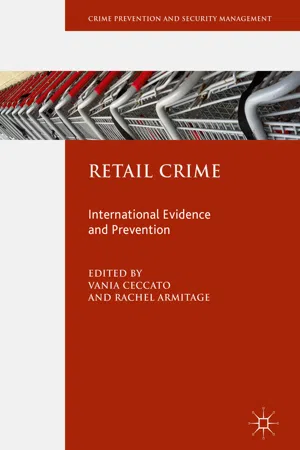Introduction
Shoplifting is the major cause of retail loss in 18 of the 24 countries surveyed in the Global Retail Theft Barometer in 2014–2015 (GRTB, 2016). In Sweden , stores experience two million shoplifting cases each year (Swedish Trade Federation, 2015). This pattern is also evident in countries like the UK and the US (Bamfield, 2012). Many of the targeted stores are on particular streets while others are part of shopping centres or outlets on the outskirts of the cities , and these stores and centres can become foci of crime. Not all of them though constitute crime attractors or generators (Brantingham & Brantingham, 1995; Franka et al., 2011), but some concentrate crime so badly (Eck, Clarke, & Guerette, 2007; Rengert et al., 2010) that they are thought to radiate crime to their vicinities, while others absorb it (Bowers, 2014). The stores’ interiors and design as well as the way products are displayed influence motivated individuals’ decision to offend or not (Cardone & Hayes, 2012), while new technologies designed to enable customer convenience are also generating new opportunities for crime (Beck & Hopkins, 2017; Taylor, 2016).
Retail crime is more than shoplifting . Employees in retail declare being 46% more likely to suffer workplace violence than the average employee in the US (Harrell, 2011). They may steal, as there is actually more theft by employees than by customers in some countries (GRTB, 2016; Hollinger & Adams, 2010). Motivation for employee theft varies (Clarke & Petrossian, 2013), but it can be linked to criminal organisations, some with connections beyond national borders (Burges, 2013), and can take a variety of forms (fraud , cargo thefts, cybercrime , corruption and lethal violence), not rarely intertwined with legal ones. Such operations ‘involves a vast array of small fish’ (Felson, 2006, p. 8). This complexity makes retail crime an issue worthy of attention by researchers, retailers, police and other professionals interested in the interplay between targets, settings and criminals.
Aim and Scope of the Book
This book contributes to this knowledge base by characterising the dynamics of retail crime from an international perspective. Special focus is given to the settings and the environments where retail crimes take place. Retail crime encompasses any criminal act against a store, a company or a conglomerate of companies, their properties as well as their employees and customers . Some of these crimes are composed of multiple events; some taking place far beyond the boundary of the store, affecting stakeholders along the product supply chain, such as Organised Retail Crime (ORC). The book also explores the use technology along the product supply chain; how it can affect crime opportunities and to some extent prevent crime.
The book is grounded in environmental criminological theory and the principles of situational crime prevention, but approaches this crime problem from a multidisciplinary perspective. The book also offers both theoretical and practical perspectives on current crime prevention activities directed to crimes that most affect stores, retailers, shopping malls and commercial conglomerations located both within the inner cities and on the outskirts of towns and cities . The book offers state-of-the-art research on retail crime from Europe, the US, Middle East, South America and Australia . As such, its appeal lies with both academics and practitioners from a variety of disciplines and backgrounds.
A decision has been made to exclude from the scope of the book the following issues: cybercrime , online theft, fraud , online loss—topics covered within other key texts. In addition, this book does not include the politics of retail crime and crime prevention. Although the book touches upon issues of crime by employees, terrorism, riots/looting/activism in retail environments, and managerial and organisational issues related to crime and crime prevention in retail environments, these topics have not been the focus of this book. Some of these issues have already been presented elsewhere (for instance , Bamfield, 2012, 2014; Beck, 2016a, 2016b; Beck & Peacock, 2009; Gill, 1994 (2005); Gill, Bilby, & Turbin, 1999; Hayes, 2007; Wiefel & Gregus, 2016).
Book Structure
The book is divided into 6 parts and 16 chapters. Part I establishes the purpose and scope of the book. In Chap. 1, the structure and the contents of the book are outlined. The chapter includes an introduction to the theme, the book scope and delimitations, key definitions and theoretical principles used to structure this edited volume and support the reading of the chapters. Chapter 2, by Joshua Bamfield , presents the international trends in retail crime. The chapter also introduces to the topic of retail prevention practices that we revisit at the end of the book.
Part II focuses on the types of products that are most stolen as well as on the interplay between the product, settings and offenders in retail environments. This is the micro scale of retail crime that focuses on products, settings and to some extent, store environmental features. Brian Smith and Ron Clarke , using the CRAVED approach, focus on shoplifted, fast-moving goods to illustrate offenders’ decision -making. These authors are particularly interested in finding out the types of goods most stolen by offenders . In the same vein of thought, James Hunter, Laura Garius , Paul Hamilton and Azrini Wahidin study prolific theft offenders to understand who these offenders are and the reasons they steal from shops. The case study is based on evidence from the United Kingdom. Emmeline Taylor takes a step ahead by looking at the influence of new technology on offender’s behaviour in retail environments and in particular, customer-operated payment systems, self-service checkouts and their impacts on retail crime.
Part III of this book is devoted to crime and perceived safety in retail environments, also on the micro scale . In particular, the focus shifts towards the importance of the settings and retail environments on off...
